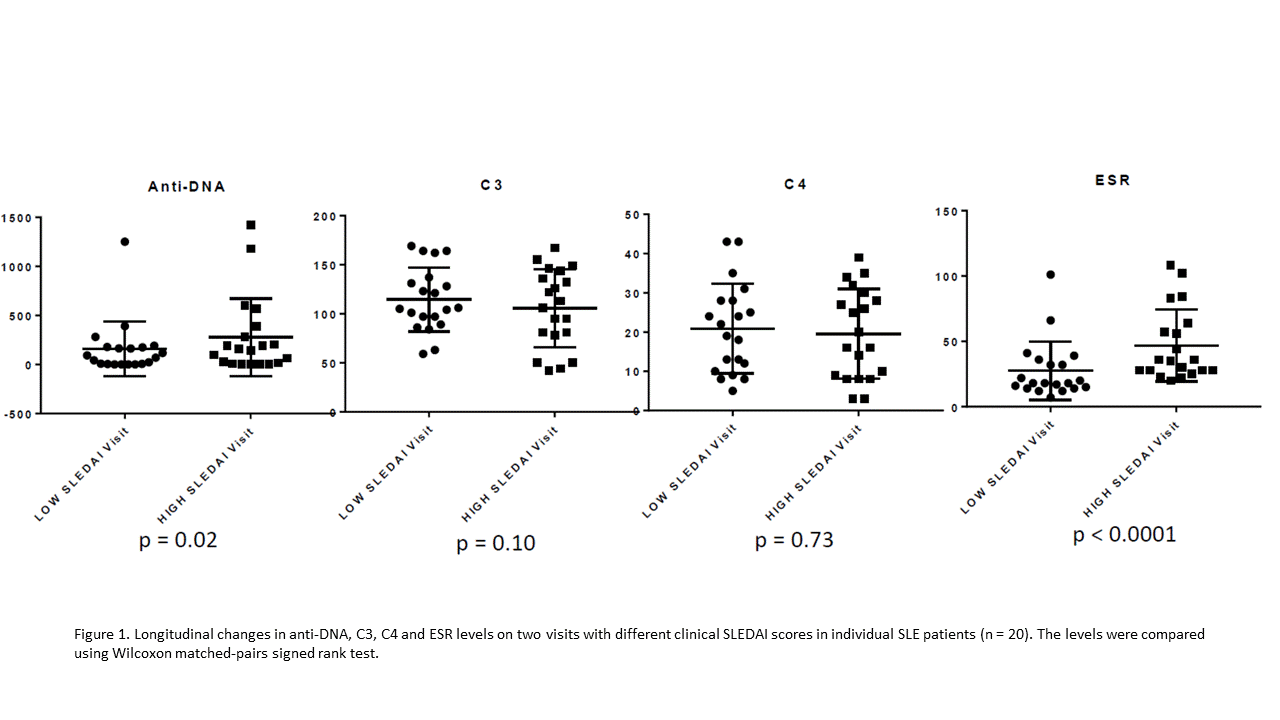Session Information
Date: Monday, October 22, 2018
Title: Systemic Lupus Erythematosus – Clinical Poster II: Biomarkers and Outcomes
Session Type: ACR Poster Session B
Session Time: 9:00AM-11:00AM
Background/Purpose: SLEDAI is a global disease activity index for SLE and includes anti-DNA and complement levels. However, elevated anti-DNA or low C3 & C4 levels may not be normalized in certain patients when SLE disease activity improve with treatment. In previous studies, ESR was associated with disease activity in SLE. In this study, we evaluated if ESR was a better marker for SLE disease activity compared with anti-DNA and complement.
Methods: We examined the data of patients with SLE who were enrolled in University of Washington Lupus Repository from 2014 through 2018. We included SLE patients who presented with arthritis, mucocutaneous symptoms, serositis or nephritis and excluded those with active CNS lupus, interstitial lung disease, myositis or hemolytic anemia. Additionally, we excluded patients with concomitant diagnosis of other rheumatic diseases including RA, SSc, chronic infection including HBV, HCV, HIV, any significant comorbidities including chronic kidney disease or malignancy, and recent infection, thrombosis or surgery within 4 weeks of the visit. We selected the most recent visit from each patient and examined the relationship between disease activity measured by clinical SLEDAI scores vs. ESR, anti-DNA, C3 and C4. Clinical SLEDAI was defined as SLEDAI without anti-DNA and complement levels in this study. Next, we selected patients who had a minimum of two visits with different clinical SLEDAI scores over the study period and examined whether there were differences in ESR, anti-DNA, C3 and C4 between the two visits in individual patients.
Results: Eighty-three patients met the eligibility criteria. There was a significant correlation between ESR and clinical SLEDAI (r = 0.3, p = 0.007), which remained significant after adjusting for hemoglobin or hematocrit. Anti-DNA, C3 and C4 did not correlate with clinical SLEDAI. ESR was significantly higher in patients with moderate to severe activity (clinical SLEDAI ≥ 3) than in patients with no activity (clinical SLEDAI = 0) (p = 0.009). No differences in anti-DNA, C3 or C4 were found between the two groups. Twenty patients had a minimum of two visits with different clinical SLEDAI and mean difference in clinical SLEDAI between two visits in these patients were 4.5 ± 3.4. ESR and anti-DNA were significantly different between the two visits and C3 and C4 were not different (Fig 1).
Conclusion: ESR correlated with clinical SLEDAI in SLE patients and was higher in patients with moderate to severe activity compared to those with no activity. Anti-DNA, C3 or C4 did not correlate with clinical SLEDAI and were not different between active and inactive patients. ESR and anti-DNA were different between two visits with different clinical SLEDAI scores in individual patients while there were no differences in C3 and C4. These results suggest that ESR may be a better test than anti-DNA, C3 or C4 in assessing SLE disease activity.
To cite this abstract in AMA style:
Han BK, Rathwell E, Ng B, Wener M. Evaluation of Erythrocyte Sedimentation Rate As a Marker of Disease Activity in Patients with Systemic Lupus Erythematosus [abstract]. Arthritis Rheumatol. 2018; 70 (suppl 9). https://acrabstracts.org/abstract/evaluation-of-erythrocyte-sedimentation-rate-as-a-marker-of-disease-activity-in-patients-with-systemic-lupus-erythematosus/. Accessed .« Back to 2018 ACR/ARHP Annual Meeting
ACR Meeting Abstracts - https://acrabstracts.org/abstract/evaluation-of-erythrocyte-sedimentation-rate-as-a-marker-of-disease-activity-in-patients-with-systemic-lupus-erythematosus/

